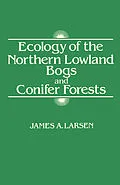Ecology of the Northern Lowland Bogs and Conifer Forests is a book on the ecology of bogs and conifer swamps and, to some extent, the marshlands. The chapters that follow are, for the most part, a review of what is known about the northern bogs and lowland forests, written in the terminology of science in the hope, as well as the expectation, that such knowledge will be of value to those who appreciate the beauty of bogs and marshlands, to ecologists and other biological scientists, naturalists, wildlife conservationists, hunters, trappers, construction engineers, as well as to others whose vocations or avocations take them afield. The discussion is devoted, at least primarily, to the ecology of one kind of wetland-the lowland bogs and conifer forests-and treats only in passing the marshlands and other kinds of vegetational communities that are also classified as wetlands. Of particular concern are the lowland peat bogs and forests, especially those that have developed to a point where their identity is indisputable for the simple reason that no other review of accumulated knowledge on these vegetational communities is presently available.
Inhalt
Preface
1 Lowland Bog and Conifer Forest Ecology: Historical Perspective
Forest Influences
Discovery of the Principles
Early Americans
Plants and Environment
2 The Organismic Forest: Historical Perspective Continued
3 Comprehending the Northern Plant Communities Early Views
4 A Thoreauvian Digression: Bog Community Composition and Structure
Bog Plant Communities
Species of the Communities
5 Plant Species of the Bogs - I
North American Habitats
6 Plant Species of the Bogs - II
7 Character Sketch of Marshland Species
8 Where the Bogs Are Found
9 Some Reflections on the Species
10 More Reflections on the Species
The Northern Ericads
Oxycoccus
Group Three
Origins
11 Origins of the Ericaceae
Tertiary, Pliocene, and Pleistocene
12 Post-Glacial Migrations
13 Some Speculation on Sclerophyllous Matters
Conditions of Life for Ericads
Morphology of the Northern Plants
14 Acidity, Minerals, and Sclerophylly
Minerals and Sclerophylly
15 More on Sclerophylly and Xeromorphy
Sclerophylly and Xeromorphy
Sclerophylly and Nutrients
The Ericoid Leaf
Integrated Factor Complex
Transpiration and Environment
Summary
16 Evergreens: Nutrient Dynamics 148
Nutrients Recycled - 1
Nutrients Recycled-2
Mineral Utilization
Precipitation of Elements
17 Nutrients and Plant Communities
Other Influences: Allelopathy
Nutrients and Succession
Rare Extreme Conditions
Summary
18 Soil Conditions and Microbiology of Bogs
Bog Waters
Microbiology of a Bog
19 The Mosses: Basic Ecology
The Significant Parameters
Mosses: Physiology and Habitat
Habitat Preference
20 Development of Communities I: Regional Relationships
Bog Communities: Structure
Organic Production
21 Development of Communities II: Broad Ecological
Relationships
The Role of Pioneer
A Successional Scheme
Regional Differences
Importance of Trees
Variations in Structure
Plant Community Variation
Water, Minerals, and Species
22 The Plant Species: Physiological Ecology
Physiological Adaptations
Adaptive Diversity
Bog, Alpine, and Arctic Comparisons
Transpiration Characteristics
23 Utilization of the Bogs
New Techniques
24 The Bog as Wildlife Habitat
The Animals: Mammals
The Animals: Birds
Epilogue
Appendix
A. Listing of Common Species Inhabiting Northern Lowland Bogs and Conifer Forests
B. Common Moss Species Inhabiting Northern Lowland Bogs and Conifer Forests
Bibliography
Index
